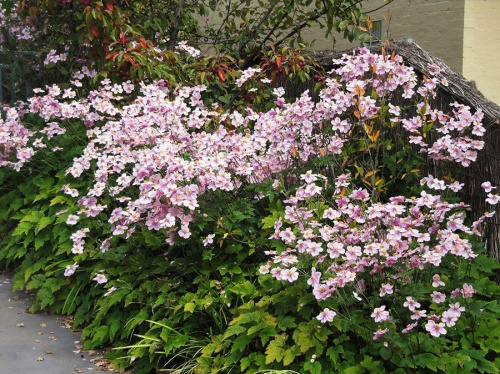
The most common variety has white flowers that give a real lift to dull days. Equally, the pink variety illustrated here makes a great show. Some years ago I was castigated by a reader who said that I should not have suggested these for any garden. I was told that I should tell readers in my next column that I had made a mistake. The writer said these should be considered a weed and can take over a garden. Lots of “shoulds” here! Needless to say, I did not make a correction and, yes, they do spread quite readily, however they are easy to control. Simply thin out after flowering with roots readily pulled out.

Will it stand the cold and frosts here in our district?
You may be surprised to know it comes from Siberia. With its huge glossy leaves it grows in bold clumps with pink flowers on long stems in winter. It has traditionally been used as a border plant along paths and driveways. Other winter-flowering perennials to plant now include Viola headrace and Iris unguilaris or winter iris. The latter has deliciously fragrant flowers that last a long time in containers. Helleborus and polyanthus are both firm favourites for winter colour.
LAST week, I suggested raising all outdoor container grown plants off the ground. This is vital for good drainage, especially with citrus and succulent plants. For the same reason, get rid of saucers under pots. If water cannot drain away the soil gets rank and root rot sets in.
The worst-case scenario is pots placed on dirt in garden beds. How often have you had a coaster come when lifting a glass? This suction is the same for outdoor pots, stopping the water draining from containers when sitting on a paved or tiled area.
EQUALLY, this applies to indoor plants. If the saucer is kept full of water root rot will be the result. For indoor plants, fill the saucer with small pebbles and place the pot on top of the pebbles. More indoor plants die from over watering than any other cause. For more information on indoor plants, refer to my Cedfacts Information Sheet “Green your home with Indoor Plants” at www.cedricbryant.com
RECENTLY, I discussed autumn foliage and many folk do not realise the difference in the leaf colour of various grape varieties. Look at the grapes at the Mt. Majura Winery on Majura Road. Glance up the side of the hill to appreciate the range of leaf colour.
This season augers well for some top-quality wines. You can plant grape vines now, but do not prune them, even if they look decidedly scraggly. Leave it until the first new shoots appear in spring to stop excessive bleeding.

There is very good information with photos on Google. Illustrated here is Amanita muscaria appearing in many gardens now, including my own. Do not touch or let your children touch these brightly coloured mushrooms. They are deadly and yet how is it that possums eat them with no ill effects?
In your garden this week
- Plant a persimmon tree for delicious fruit.
- Prune Betula pendula or Silver Birches now as they will bleed profusely if pruned in early spring.
- With Cyclamen kept in the home, always water the soil, not over the leaves to prevent mildew.
- Lift and divide chives for growing in pots or in the garden.
- Allium sativum, or garlic, can be planted now. Break up the bulbs and plant each section just below the surface.
Who can be trusted?
In a world of spin and confusion, there’s never been a more important time to support independent journalism in Canberra.
If you trust our work online and want to enforce the power of independent voices, I invite you to make a small contribution.
Every dollar of support is invested back into our journalism to help keep citynews.com.au strong and free.
Thank you,
Ian Meikle, editor




Leave a Reply